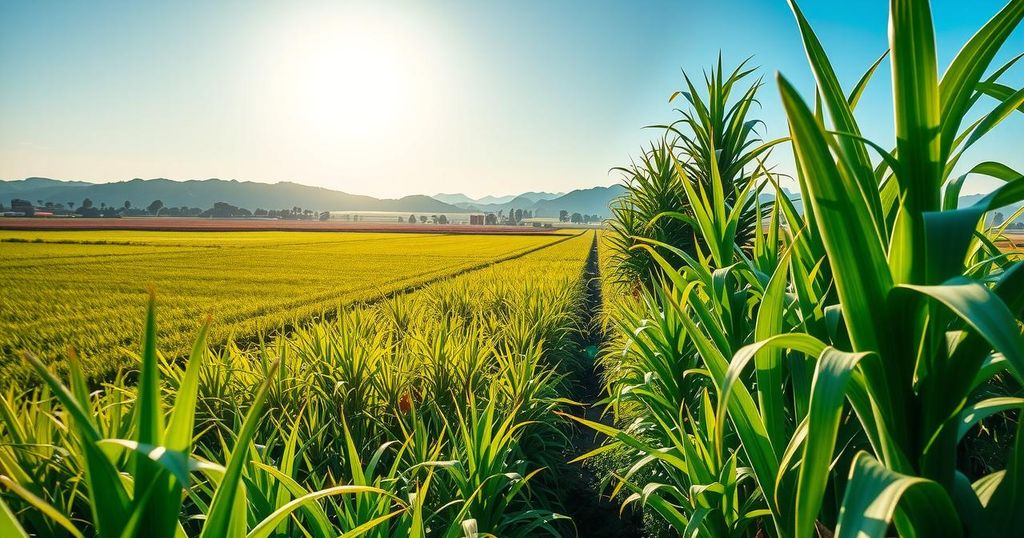Sugar Prices Surge on Reduced Global Production Estimates

Sugar prices have surged significantly due to lower production estimates in Brazil and India, with May New York sugar and London ICE white sugar experiencing notable increases. Factors influencing this rise include unfavorable crop conditions, production predictions, and exchange rates affecting export decisions. The ongoing reduction in global production forecasts by authoritative organizations signals potential market tightness ahead.
Sugar prices have significantly surged due to reduced production estimates in major producing countries such as Brazil and India. On Monday, the May New York world sugar 11 (SBK25) marked an increase of 4.06% while the May London ICE white sugar 5 (SWK25) rose by 4.30%. This upward trend followed reports indicating diminished global sugar production, particularly highlighted by Unica’s report showing Brazil’s output declined by 5.6% year-on-year.
Additionally, the Indian Sugar and Bio-energy Manufacturers Association revised its forecast for India’s sugar production for 2024/25 downward, projecting 26.4 million metric tons (MMT) instead of the previously estimated 27.27 MMT, primarily due to decreased cane yields. The favorable exchange rate for the Brazilian real against the dollar further stimulated sugar prices by discouraging exports from Brazil, thus reducing availability in the global market.
The International Sugar Organization (ISO) has also contributed to concerns with its updated forecast signaling a greater global sugar deficit of -4.88 MMT for 2024/25, increasing from a prior estimate. This shift reflects a constricted market compared to the previous surplus recorded in 2023/24. Furthermore, the ISO reduced its total sugar production forecast to 175.5 MMT, down from 179.1 MMT.
In contrast to these bearish prospects, Datagro indicated potential increases in Brazil’s sugar production of 42.4 MMT for 2025/26, citing a 6% year-on-year growth. Sugar trader Czarnikow also forecasted record production levels of 43.6 MMT in Brazil due to rising profitability in sugar production over ethanol.
On the regulatory side, the Indian government announced it would permit the export of 1 MMT of sugar as the current season progresses, which could counterbalance earlier restrictions to ensure domestic supply stability. This policy shift follows a marked limitation where only 6.1 MMT of sugar was allowed for export in the previous season.
Moreover, Thailand’s anticipated sugar production increase of 18% year-on-year to 10.35 MMT could pose a bearish outlook on global sugar prices. This increase is noteworthy, considering Thailand’s status as a significant producer and exporter, ranking third globally.
The adverse weather conditions affecting Brazil have also played a role in diminishing sugar crop yields. Notably, drought and heat contributed to substantial crop damage, particularly in São Paulo, where fires led to an estimated loss of 5 MMT of sugarcane. In response to these challenges, Brazil’s Conab agency has adjusted its sugar production estimates downward from 46 MMT to 44 MMT.
Lastly, the USDA projects a global increase in sugar production to a record of 186.619 MMT for the 2024/25 season, while also forecasting a corresponding rise in human sugar consumption. These dynamics emphasize the complex interplay of factors influencing sugar pricing and production forecasts across the globe.
In summary, the surge in sugar prices is a direct consequence of reduced production estimates in both Brazil and India. Various reports indicate lowered outputs, adverse climatic conditions, and adjustments in export policies all contribute to this trend. Despite some projections for future increases in production, the current market remains tight, indicating fluctuating price trajectories driven by these evolving conditions.
Original Source: www.tradingview.com








